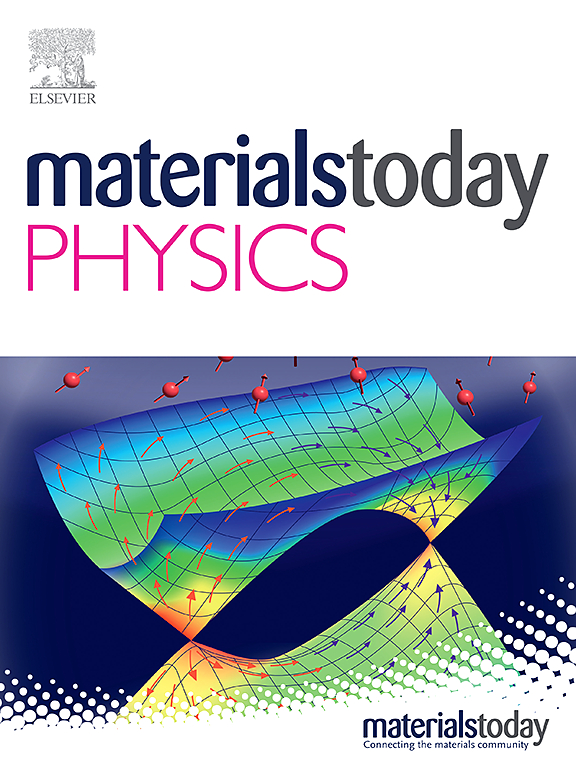Efficient microwave absorber for phase-engineered modulation of MoS2 induced by trace atom doping
IF 10
2区 材料科学
Q1 MATERIALS SCIENCE, MULTIDISCIPLINARY
引用次数: 0
Abstract
The traditional electromagnetic microwave (EM) absorption materials are limited by the electromagnetic response characteristics dominated by a single loss mechanism, and it is difficult to realize the cooperative optimization of multiple loss mechanisms and impedance matching. In this study, the phase structure engineering and defect characteristics of MoS2 were controlled by heteroatom doping strategy, and Fe-doped yolk-shell MoS2 nanoflower microspheres EM absorption material were successfully prepared. The introduction of Fe atoms can form an atomic-level " charge-enriched center " defect, induce crystal structure distortion, and thus realize the construction of a high-density and stable 1T/2H heterogeneous interface. The ratio of 1T/2H phase increases with the increase of the gradient of Fe atom doping. Specifically, the 8Fe-MoS2 sample demonstrated excellent EM absorption performance at a matching thickness of 1.95 mm, with a maximum effective absorption bandwidth (EAB) of 5.36 GHz and a minimum reflection loss (RL) of −72.18 dB (1.65 mm). Through detailed characterization and multi-scale simulation, it is revealed that the superior EM absorption performance is the result of the synergistic effect of Fe defect induced polarization, interface polarization at high density heterogeneous interface, resistance loss and EM transmission path optimization. This multi-scale control strategy precisely combines the coupling effect of MoS2's defect characteristics and phase structure with multiple dielectric loss mechanisms, which provides a new design idea for developing high-performance MoS2-based EM absorption materials.

痕量原子掺杂诱导二硫化钼相位工程调制的高效微波吸收剂
传统的电磁微波吸收材料受限于单一损耗机制主导的电磁响应特性,难以实现多种损耗机制的协同优化和阻抗匹配。本研究通过杂原子掺杂策略控制二硫化钼的相结构工程和缺陷特性,成功制备了fe掺杂的蛋黄壳二硫化钼纳米花微球电磁吸收材料。Fe原子的引入可以形成原子级“富电荷中心”缺陷,诱导晶体结构畸变,从而实现高密度稳定的1T/2H非均相界面的构建。1T/2H相的比值随着Fe原子掺杂梯度的增大而增大。具体而言,8Fe-MoS2样品在匹配厚度为1.95mm时表现出优异的电磁吸收性能,最大有效吸收带宽(EAB)为5.36 GHz,最小反射损耗(RL)为-72.18 dB (1.65 mm)。通过详细表征和多尺度模拟,揭示了优越的电磁吸收性能是铁缺陷诱导极化、高密度非均质界面界面极化、电阻损失和电磁传输路径优化协同作用的结果。这种多尺度控制策略将MoS2缺陷特性和相结构的耦合效应与多种介质损耗机制精确地结合在一起,为开发高性能MoS2基电磁吸收材料提供了新的设计思路。
本文章由计算机程序翻译,如有差异,请以英文原文为准。
求助全文
约1分钟内获得全文
求助全文
来源期刊

Materials Today Physics
Materials Science-General Materials Science
CiteScore
14.00
自引率
7.80%
发文量
284
审稿时长
15 days
期刊介绍:
Materials Today Physics is a multi-disciplinary journal focused on the physics of materials, encompassing both the physical properties and materials synthesis. Operating at the interface of physics and materials science, this journal covers one of the largest and most dynamic fields within physical science. The forefront research in materials physics is driving advancements in new materials, uncovering new physics, and fostering novel applications at an unprecedented pace.
 求助内容:
求助内容: 应助结果提醒方式:
应助结果提醒方式:


